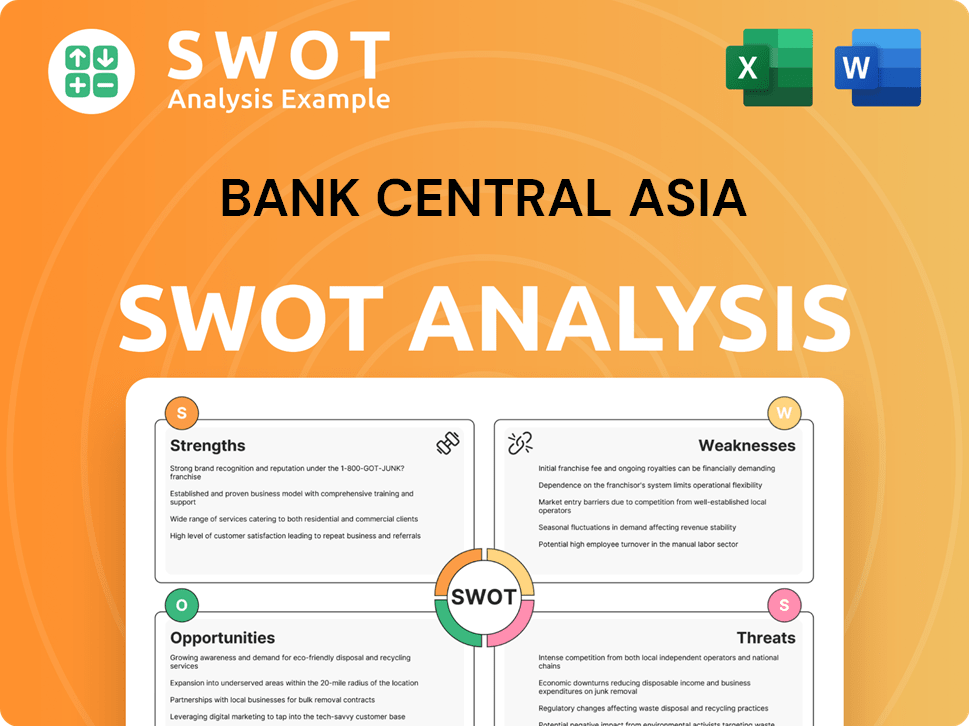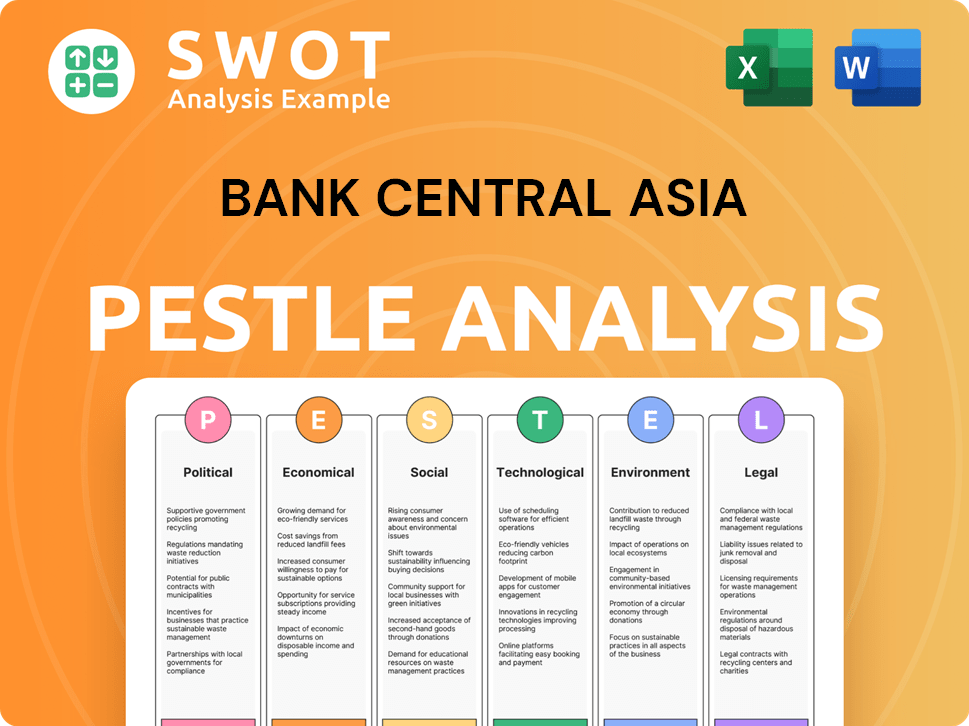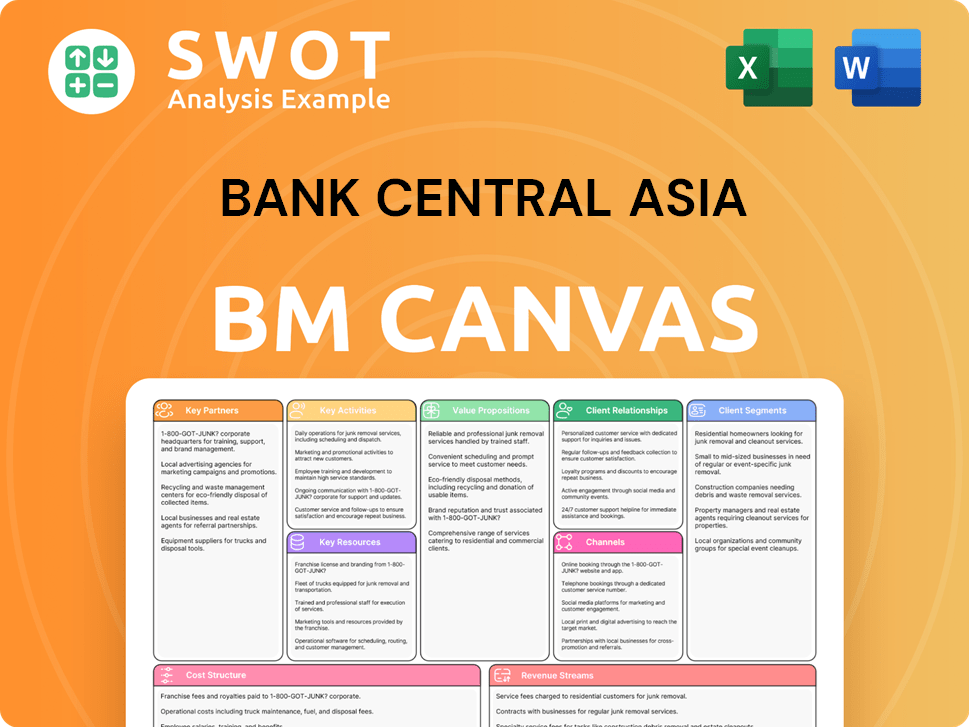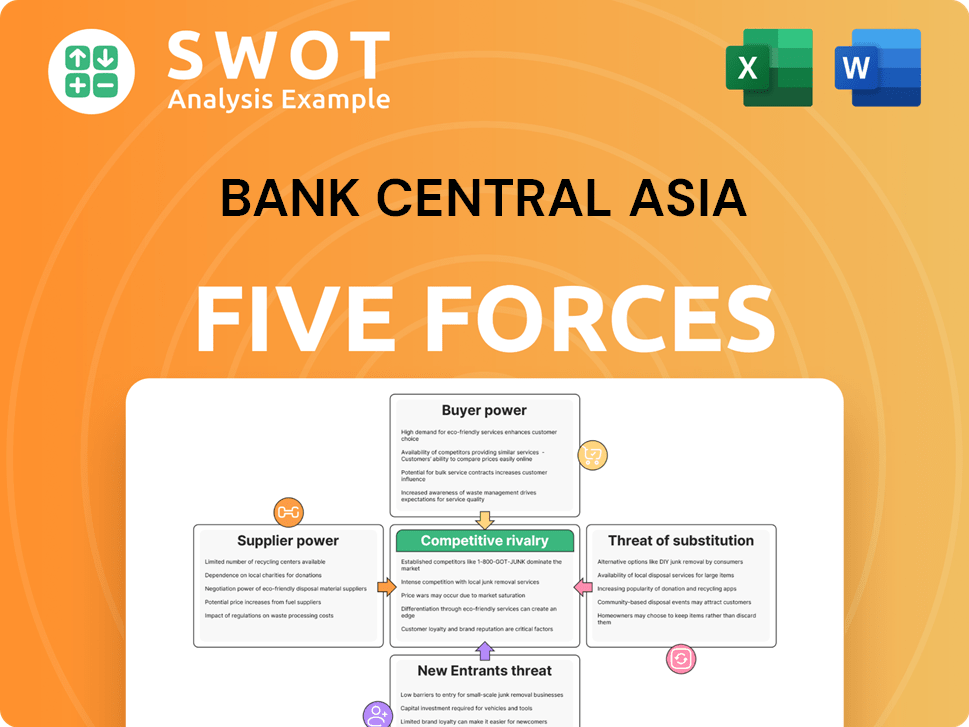Bank Central Asia Bundle
Can BCA Maintain Its Dominance in Indonesia's Banking Sector?
Bank Central Asia (BCA) isn't just a bank; it's a financial powerhouse that has shaped the Indonesian banking industry for decades. From its humble beginnings in 1957 to its current status, BCA has consistently demonstrated remarkable growth and adaptability. Understanding the Bank Central Asia SWOT Analysis is crucial to understanding its market position.

Delving into the BCA competitive landscape is essential to understanding its success. This analysis explores BCA's competitors and their strategies, providing insights into BCA's market share and market position of BCA within the Indonesian banking industry. We'll uncover BCA's strengths and weaknesses, and how it compares to other banks, offering a comprehensive look at the financial services Indonesia sector.
Where Does Bank Central Asia’ Stand in the Current Market?
Bank Central Asia (BCA) holds a strong market position within the Indonesian banking industry. It is recognized as Indonesia's largest private bank by market capitalization and the second largest by assets. This prominent status is supported by its robust financial health, reflected in a consolidated Capital Adequacy Ratio (CAR) of 29.3% by FY24.
BCA's core operations focus on providing a wide range of financial services to individuals, SMEs, and corporations. These services include deposit accounts, loans, credit cards, wealth management, and digital banking solutions. The bank's commitment to digital transformation is evident in its expanding myBCA features and investment in cybersecurity.
BCA's value proposition lies in its comprehensive financial solutions and its ability to adapt to the evolving needs of its customers. The bank’s strong CASA ratio, at 82% as of year-end 2024, highlights its ability to maintain a strong funding base. This has helped the bank to remain a leader among Indonesia's 'Big 4 Banks' and to maintain profitability above the industry average in 2025.
BCA offers a wide array of financial products and services. These include deposit accounts, loans (corporate, commercial, SME, and consumer), credit cards, wealth management, and digital banking solutions. The bank caters to individuals, SMEs, and corporations, providing comprehensive financial solutions to meet diverse needs.
BCA's loan portfolio has shown robust growth across various segments. Corporate loans increased by 13.9% year-on-year to Rp443.4 trillion, commercial loans expanded by 9.9% to Rp137.4 trillion, and SME loans grew by 12.9% to Rp124.5 trillion. Consumer loans also saw an 11.3% year-on-year increase, reaching Rp225.7 trillion.
BCA is heavily investing in its digital ecosystem to enhance customer experience and operational efficiency. This includes expanding myBCA features, investing in cybersecurity, and growing digital merchant services. Mobile banking is a key driver of transaction volume, with a 22.2% year-on-year growth in mobile and internet banking transactions.
BCA operates a vast network across Indonesia, with a presence in Sumatera, Java, Kalimantan, and East Indonesia, as well as overseas operations. This extensive network allows BCA to serve a broad customer base and maintain a strong market presence throughout the country. This is a key factor in its competitive advantage.
BCA's strong financial performance and strategic initiatives have solidified its market position. The bank's high CASA ratio and robust loan growth demonstrate its financial strength and ability to attract and retain customers. For more insights, you can explore Revenue Streams & Business Model of Bank Central Asia.
- BCA's market capitalization makes it the largest private bank in Indonesia.
- The bank's CAR of 29.3% indicates strong financial health.
- BCA is expected to maintain profitability above the industry average in 2025.
- Digital banking transactions have seen significant growth, reflecting the bank's digital transformation efforts.
Bank Central Asia SWOT Analysis
- Complete SWOT Breakdown
- Fully Customizable
- Editable in Excel & Word
- Professional Formatting
- Investor-Ready Format

Who Are the Main Competitors Challenging Bank Central Asia?
The Indonesian banking sector is intensely competitive, with Bank Central Asia (BCA) facing significant rivals. Understanding the BCA competitive landscape is crucial for assessing its market position and future prospects. This analysis focuses on BCA's competitors and their strategies within the Indonesian banking industry.
BCA competes with both state-owned and private banks. The primary competitors include the other 'Big 4 Banks' in Indonesia. These banks continually vie for market share BCA, influencing the dynamics of financial services Indonesia.
BCA's main competitors in Indonesia are primarily the other 'Big 4 Banks'. These include Bank Mandiri (BMRI), Bank Rakyat Indonesia (BBRI), and Bank Negara Indonesia (BBNI). Each bank employs distinct strategies, impacting the competitive analysis Bank Central Asia.
Bank Mandiri has shown impressive loan growth, with a 22.7% year-on-year increase as of November 2024, the highest among its peers. Its digital platforms, such as LIVIN and KOPRA, strengthen its funding base and income streams.
Bank Rakyat Indonesia is a major player, especially in MSME lending, but loan growth slowed to 5.0% year-on-year as of November 2024. Concerns exist regarding asset quality, with higher credit costs anticipated in 2025.
Bank Negara Indonesia showed moderate performance with loan growth of 11.0% year-on-year as of November 2024. Its high Loan-to-Deposit Ratio (LDR) puts pressure on it in a tight liquidity environment.
Competitors challenge BCA through aggressive loan growth, extensive branch networks, and digital innovation. The sector is experiencing intense competition for low-cost funding. Analysts predict less aggressive loan competition in 2025 due to high funding costs.
Fintech companies and digital banks are disrupting the traditional landscape, offering innovative solutions. BCA's acquisition of PT Bank Digital BCA in October 2019 strengthened its digital banking capabilities.
The market position of BCA is influenced by its strengths in low-cost funding and transaction banking. Competitors focus on specific segments or offer digital innovations. The recent trends in the Indonesian banking sector include a push for digital transformation.
To understand how does BCA compare to other banks?, it's essential to consider their strengths and weaknesses. BCA's strengths and weaknesses, along with its competitive advantages, are key factors. The financial performance of BCA competitors and their strategic responses shape the overall market environment. For more detailed insights, you can refer to the comprehensive analysis of BCA's strategies for market dominance available in the article about Bank Central Asia.
BCA's market share compared to competitors and its customer base and demographics are crucial. Examining BCA's future growth prospects and its response to competitor strategies provides a comprehensive view.
- Digital Banking: The impact of digital banking on BCA's competitors is significant, driving innovation and competition.
- Loan Growth: Banks are competing aggressively in specific loan segments.
- MSME Lending: BBRI's focus on MSMEs is a key differentiator.
- Funding Costs: High funding costs are influencing loan competition dynamics.
Bank Central Asia PESTLE Analysis
- Covers All 6 PESTLE Categories
- No Research Needed – Save Hours of Work
- Built by Experts, Trusted by Consultants
- Instant Download, Ready to Use
- 100% Editable, Fully Customizable

What Gives Bank Central Asia a Competitive Edge Over Its Rivals?
Understanding the BCA competitive landscape involves recognizing its key strengths and strategic positioning within the Indonesian banking industry. BCA's competitive advantages have enabled it to maintain a leading position. This analysis delves into the core elements that define its success and set it apart from its BCA competitors.
BCA has consistently demonstrated strong financial performance and strategic foresight. Its ability to adapt to market changes and leverage technological advancements has been crucial. This article will explore the factors that contribute to BCA's market share and its strategies for maintaining a competitive edge in the financial services Indonesia sector.
BCA boasts a leading transaction banking franchise, which is fundamental to its robust funding base. As of the end of 2024, the bank's Current Account Savings Account (CASA) ratio stood at 82%. This high CASA ratio provides substantial liquidity and a cost advantage. This allows BCA to maintain a healthy Net Interest Margin (NIM), projected to reach 5.9% in 2025.
BCA demonstrates superior asset quality, with a loans-at-risk ratio of 5.3% at the end of 2024 and a Stage 3 loans ratio of 1.8%. These figures are among the lowest compared to domestic peers. Strong risk management contributes to BCA's profitability, which is expected to remain above the industry average in 2025.
BCA has an extensive and evolving digital banking ecosystem. Platforms like BCA mobile and myBCA have sustained its deposit franchise and driven high transaction volumes. The myBCA application is continually optimized for customer convenience. This includes various payment methods for online transactions and features like peer-to-peer transfers using QR code technology.
BCA's strong brand equity and customer trust are significant assets. In March 2025, Brand Finance ranked BCA as the world's strongest banking brand for the second consecutive year, with a Brand Strength Index (BSI) score of 97.1 out of 100 and an AAA+ brand rating. The bank's consolidated CAR of 29.3% by FY24, the highest among Indonesia's 'Big 4 Banks,' provides a strong capital buffer.
BCA's competitive advantages are sustained through continuous investment and a customer-centric approach. The bank's focus on technology, human resources, and customer satisfaction ensures its continued success. Understanding the Target Market of Bank Central Asia is also key to appreciating its strategic focus.
- Leading transaction banking franchise and high CASA ratio.
- Superior asset quality and robust risk management practices.
- Extensive and continuously evolving digital banking ecosystem.
- Strong brand equity and high customer trust.
Bank Central Asia Business Model Canvas
- Complete 9-Block Business Model Canvas
- Effortlessly Communicate Your Business Strategy
- Investor-Ready BMC Format
- 100% Editable and Customizable
- Clear and Structured Layout

What Industry Trends Are Reshaping Bank Central Asia’s Competitive Landscape?
The Indonesian banking industry is undergoing significant transformation, with digitalization, economic uncertainties, and evolving consumer preferences shaping the competitive landscape. The focus for financial institutions is on navigating these challenges while capitalizing on growth opportunities. This requires strategic adaptation, technological investments, and a customer-centric approach to maintain and enhance market position.
For Bank Central Asia, understanding the current industry dynamics is crucial for strategic planning and maintaining its strong position. The bank faces both challenges and opportunities in the rapidly changing Indonesian banking sector. A comprehensive understanding of BCA's competitive landscape is essential for effective decision-making.
Digitalization is a primary driver, with increasing adoption of digital banking solutions and e-wallets. QRIS payments are experiencing rapid growth, with 175% year-on-year growth in 2024. Economic uncertainties, including global economic factors, are influencing liquidity and demand, impacting lending rates.
Rising cyber threats and the need for continuous technology investment pose challenges. Tight liquidity, with an LDR of 87.5% as of October 2024, and increasing cost of funds impact profitability. Domestic economic growth is projected to slow slightly to 4.9% year-on-year in 2025.
Credit growth is projected between 9-11% and third-party funds (DPK) to grow by 6-8% in 2025. Government stimulus and lower benchmark interest rates support growth. Banks can focus on industries with strong performance and growth potential. Attracting external forces presents opportunities.
BCA aims for sustainable growth, focusing on corporate, SME, and consumer segments, with emphasis on downstream industries and renewable energy. Moderate loan growth of 7-8% is projected for 2025. The bank's strong CASA ratio and digital ecosystem are key assets.
BCA's strategic initiatives and operational adjustments are critical for navigating the BCA competitive landscape and capitalizing on emerging opportunities. The bank's focus on digitalization, sustainable financing, and customer-centric services will be key to maintaining its market position and driving future growth. Understanding BCA's competitors is vital to its success.
- Enhancing the digital ecosystem, including the myBCA application and digital merchant services, to capture growth in the digital-first economy.
- Increasing loans to sustainable sectors, which grew by 19% year-on-year to Rp235 trillion by March 2025, accounting for 25% of its total financing portfolio, indicating strategic alignment with future-proof initiatives.
- Maintaining a strong CASA ratio and ample liquidity to navigate tight liquidity conditions. This is crucial for the market share BCA.
- Focusing on corporate, SME, and consumer segments, with particular emphasis on downstream industries, infrastructure, and renewable energy, to drive sustainable growth.
- Adopting a cautious approach to lending, prioritizing industries with strong business performance and growth potential.
Bank Central Asia Porter's Five Forces Analysis
- Covers All 5 Competitive Forces in Detail
- Structured for Consultants, Students, and Founders
- 100% Editable in Microsoft Word & Excel
- Instant Digital Download – Use Immediately
- Compatible with Mac & PC – Fully Unlocked

Related Blogs
- What are Mission Vision & Core Values of Bank Central Asia Company?
- What is Growth Strategy and Future Prospects of Bank Central Asia Company?
- How Does Bank Central Asia Company Work?
- What is Sales and Marketing Strategy of Bank Central Asia Company?
- What is Brief History of Bank Central Asia Company?
- Who Owns Bank Central Asia Company?
- What is Customer Demographics and Target Market of Bank Central Asia Company?
Disclaimer
All information, articles, and product details provided on this website are for general informational and educational purposes only. We do not claim any ownership over, nor do we intend to infringe upon, any trademarks, copyrights, logos, brand names, or other intellectual property mentioned or depicted on this site. Such intellectual property remains the property of its respective owners, and any references here are made solely for identification or informational purposes, without implying any affiliation, endorsement, or partnership.
We make no representations or warranties, express or implied, regarding the accuracy, completeness, or suitability of any content or products presented. Nothing on this website should be construed as legal, tax, investment, financial, medical, or other professional advice. In addition, no part of this site—including articles or product references—constitutes a solicitation, recommendation, endorsement, advertisement, or offer to buy or sell any securities, franchises, or other financial instruments, particularly in jurisdictions where such activity would be unlawful.
All content is of a general nature and may not address the specific circumstances of any individual or entity. It is not a substitute for professional advice or services. Any actions you take based on the information provided here are strictly at your own risk. You accept full responsibility for any decisions or outcomes arising from your use of this website and agree to release us from any liability in connection with your use of, or reliance upon, the content or products found herein.